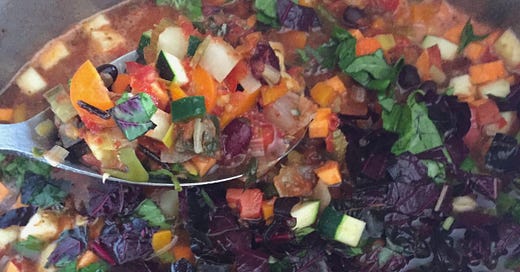Garden Minestrone Soup
This recipe is an upgraded version from an earlier version of my recipe book (Recipes For Reciprocity) but did not make it into the final printed edition due to printing budget constraints
I have always loved minestrone soup over since my childhood as my mom was a great soup maker. When her homemade version was not available I would go to the grocery store to try and find a facsimile but it was never the same. Thus, minestrone was one of the very first soups I taught myself to make in my youth and I have been improving on my recipe ever since my early 20-s.
This recipe below is a version of that recipe (from before I decided to abstain from eating meat) that was intended to be included in my book (Recipes For Reciprocity : The Regenerative Way From Seed To Table) but I ended up having to cut it from the final draft due to printing budget limitations.
Well I don’t want this recipe to be limited to being enjoyed in our home so I am gonna share an upgraded version of it with you all now.
This soup is a fantastic way to use up an abundance of tomatoes, squash, basil, beans, peppers and amaranth. The version I will share with you below checks all the nutritional checkboxes and goes way off the charts into the realm of medicinal superfood territory.
History of Minestrone
Minestrone has been a staple in the Italian diet since at least the 2nd century B.C., when Rome was founded. During this time, economic growth (otherwise known as the mass murder of, theft from and assimilation of indigenous peoples far and wide) allowed a variety of new vegetables to flood the market.
In the Middle Ages, minestrone gained popularity as a way to use up leftover vegetables. By the 16th century, tomatoes and potatoes had arrived from the New World and were being added to minestrone.
Today, there are as many versions of minestrone as there are Italian grandmothers. Each region and even each family has its own version of the soup.
Minestrone is part of the cucina povera (or "poor kitchen") tradition in Italy. This tradition emphasizes simple, inexpensive meals that can be made in large quantities and that make use of every part of an ingredient.
Despite its humble origins, minestrone has become a beloved dish around the world. It embodies the Italian philosophy of using simple, fresh ingredients to create dishes that are both delicious and nutritious.
Instead of being limited to only a few vegetable crops, Italians could now enjoy a wide variety. It was this new mix of vegetables, and plates being made, that started the minestrone craze.
Gathering ingredients from the garden (or leftover meals), Italian peasants would make this “poor man’s soup”. That’s why even to this day, there’s no one exact recipe for how this soup should be made.
My original version of this soup (circa 2017):
Okay, so basically all I did for adapting/enhancing this recipe is switch the turkey/chicken broth for veggie broth made with Amarnath Greens, Kale Stems, Kombu and herbs and then I used organic legumes, added wild rice, stinging nettles, homegrown oyster mushrooms, Goji berries, Goji Leaves, Hopi Red Amaranth greens and extra fresh basil as well as extra sweet potatoes (1 more than the recipe above calls for).
Another fun optional ingredient is adding some Rhodiola Rosea or Rhodiola integrifolia root powder while simmering.
I added the wild rice uncooked at the onion frying stage to pan sear the rice to help it open up sooner and added the kale stems and kombu (ripped into small 1cm or smaller pieces) soon after. The oyster mushrooms were added in the place of brown/white mushrooms and the Red Amaranth Greens were added just before the fully constructed soup was brought to a boil before simmering.
What that means in a medicinal/nutritional sense is that this soup offers Ocular-Regenerative/Ocular-Protective, Glyphosate detoxing, Cardio-Protective (and perhaps Cardio-Regenerative Potential), Radioprotective, Radiomitigative and Radiomodulatory and Immune system optimizing benefits.
Plus, it taste amazing to boot! ;)
Here are some pics of how it came together and turned out.


Well I hope some of you out there will give making your own version of this a try. It is truly delicious and fulfilling on many levels.
The recipe above is an upgraded and enhanced version of a recipe from an earlier version my book (cover shown in image below).
If you would like to have access to well over a hundred other fun and nutritious recipes like this there is info to where you can purchase either a physical or digital copy of my book below.

For those interested in purchasing a physical copy of the book you can do so through this link:
https://recipesforreciprocity.com/shop/softcover/










Your good food always looks so yummy. Thanks for sharing : )
Loving your book Gavin!
Recommending it to all of my ecological and biodiversity minded friends...